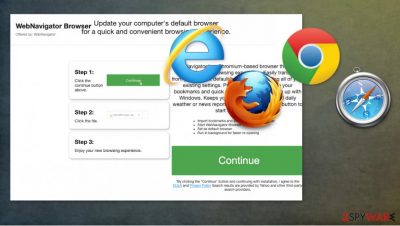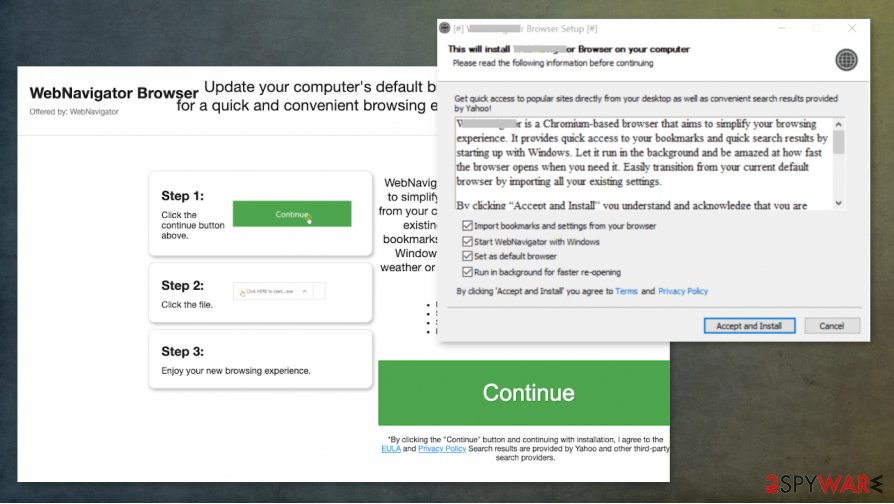WebNavigatorBrowser (Easy Removal Guide) - Free Instructions
WebNavigatorBrowser Removal Guide
What is WebNavigatorBrowser?
WebNavigatorBrowser is the browser hijacker that creates issues with the performance and online traffic

Unfortunately, when the PUP triggers all the changes in specific sections of the browser like homepage, new tab, search engine, default tools, or functions all the searches automatically go through the shady domain. In addition, WebNavigatorBrowser virus is the one that focuses on redirects and pop-up advertisements. This is one of many PUPs related to third-party sponsors and commercial content creators, so it becomes impossible to access wanted material online without entering an ad or site with intrusive advertisements and possibly ad-tracking functionalities.[1]
| Name | WebNavigatorBrowser |
|---|---|
| Type | Browser hijacker/ Potentially unwanted program |
| Symptoms | The page focuses on redirecting people to advertisers' sites, delivering pop-ups with commercial content. |
| Distribution | Freeware installations trigger automatic downloads of the potentially unwanted programs, so you cannot notice the infection happening or avoid the infiltration. Other programs can easily drop the adware or a browser hijacker[2] on the machine when the computer is affected already |
| Issues |
There are many programs that can be added without your consent, you also encounter redirects to commercial pages and possibly malicious programs or sites. These third-party advertisements can lead to other issues related to suspicious online material and ad-tracking |
| Elimination | You should remove WebNavigatorBrowser with the help of anti-malware tools or security programs that can check for various parts of the PUP and remove the intruder properly |
| Repair | The system gets affected by the intruder, so you should clear the damage by repairing the altered data or anything that gets damaged. FortectIntego should help with these issues |
WebNavigator Browser is the program identical to WebExplorer that is the program creating various issues with the machine because it triggers changes on the web browser. This is the program developed by the same shady company Better Cloud Solutions, so there are many issues that you can encounter while this PUP is triggering all the changes and other problems.
WebNavigatorBrowser is the Chromium-based web browser that should improve your experience online because it offers to show improved search results, provide access to exclusive material, and manage your device better. However, this is the program created to expose users to other sponsored material and control the online traffic.
You should note that WebNavigator virus is not the safest web browser add-on to use, especially when it gets installed out of nowhere and triggers those shady pop-ups and redirects. It should be removed from the browser, even though it is not residing there only. It mainly gets installed during other freeware installations as the additional application included in the bundle.

You need a proper WebNavigatorBrowser removal process if you want to get rid of the issues created by this application. It can take time if you decide to find all the components yourself. Experts[3] note about the persistence and intrusiveness of the PUP like this.
Pay attention to such tips like clearing the machine fully, and eliminating any suspicious extensions, add-ons from the browser. This is how you can remove WebNavigatorBrowser with all the traces and possibly related applications. Running tools like SpyHunter 5Combo Cleaner or Malwarebytes can improve the security state significantly.
However, you can remove WebNavigatorBrowser using anti-malware or system security software, but the damage and alterations remain there. Tools like FortectIntego could help with system alterations, registry entry changes, and damage that is done to functions f the PC.

Changes to web browser settings start with the pUP infection
You cannot be sure how and who installed the potentially unwanted program that managed to access your web browser because it happens behind your back and can be silent. In most cases, your device is infected way before the symptoms because PUP gets dropped when you install the freeware on the machine or fall for the promotional advertisement.
Scammy advertisements and deceptive sites can trigger the automatic drop of the PUP, so you only need to click on insecure pop-up or redirect to cause such infiltration. You can control such processes if you pay close attention to content that you visit or get unwantedly exposed to.
Choosing Advanced or Custom installation options can also be a great way to avoid these infections. Especially when users tend to go for torrent sites, pirating services, or other free domains for their programs, such step can be crucial.
You need to focus on the proper WebNavigatorBrowser termination
There are many ways that lead to WebNavigator Browser virus infection, so you cannot be sure how long this program is running on the computer or mobile device. This fact can determine how persistent the PUP is and how difficult it can be to delete it.
However, based on similar intruders in this category, WebNavigatorBrowser removal should give the best results when the anti-malware tools are in use too. If you run the proper system scan, the AV detection based tool can find all the intruders and traces of the hijacker automatically.
When you remove WebNavigatorBrowser, you should also remember to check web browsers for anything suspicious and terminate programs that raise any questions. Also, system repair is important and needed, when the PUP can access and alter places like Windows Registry. For that, rely on PC repair apps.
You may remove virus damage with a help of FortectIntego. SpyHunter 5Combo Cleaner and Malwarebytes are recommended to detect potentially unwanted programs and viruses with all their files and registry entries that are related to them.
Getting rid of WebNavigatorBrowser. Follow these steps
Uninstall from Windows
Clear the system from anything WebNavigatorBrowser – related
Instructions for Windows 10/8 machines:
- Enter Control Panel into Windows search box and hit Enter or click on the search result.
- Under Programs, select Uninstall a program.

- From the list, find the entry of the suspicious program.
- Right-click on the application and select Uninstall.
- If User Account Control shows up, click Yes.
- Wait till uninstallation process is complete and click OK.

If you are Windows 7/XP user, proceed with the following instructions:
- Click on Windows Start > Control Panel located on the right pane (if you are Windows XP user, click on Add/Remove Programs).
- In Control Panel, select Programs > Uninstall a program.

- Pick the unwanted application by clicking on it once.
- At the top, click Uninstall/Change.
- In the confirmation prompt, pick Yes.
- Click OK once the removal process is finished.
Delete from macOS
Remove items from Applications folder:
- From the menu bar, select Go > Applications.
- In the Applications folder, look for all related entries.
- Click on the app and drag it to Trash (or right-click and pick Move to Trash)

To fully remove an unwanted app, you need to access Application Support, LaunchAgents, and LaunchDaemons folders and delete relevant files:
- Select Go > Go to Folder.
- Enter /Library/Application Support and click Go or press Enter.
- In the Application Support folder, look for any dubious entries and then delete them.
- Now enter /Library/LaunchAgents and /Library/LaunchDaemons folders the same way and terminate all the related .plist files.

Remove from Microsoft Edge
Delete unwanted extensions from MS Edge:
- Select Menu (three horizontal dots at the top-right of the browser window) and pick Extensions.
- From the list, pick the extension and click on the Gear icon.
- Click on Uninstall at the bottom.

Clear cookies and other browser data:
- Click on the Menu (three horizontal dots at the top-right of the browser window) and select Privacy & security.
- Under Clear browsing data, pick Choose what to clear.
- Select everything (apart from passwords, although you might want to include Media licenses as well, if applicable) and click on Clear.

Restore new tab and homepage settings:
- Click the menu icon and choose Settings.
- Then find On startup section.
- Click Disable if you found any suspicious domain.
Reset MS Edge if the above steps did not work:
- Press on Ctrl + Shift + Esc to open Task Manager.
- Click on More details arrow at the bottom of the window.
- Select Details tab.
- Now scroll down and locate every entry with Microsoft Edge name in it. Right-click on each of them and select End Task to stop MS Edge from running.

If this solution failed to help you, you need to use an advanced Edge reset method. Note that you need to backup your data before proceeding.
- Find the following folder on your computer: C:\\Users\\%username%\\AppData\\Local\\Packages\\Microsoft.MicrosoftEdge_8wekyb3d8bbwe.
- Press Ctrl + A on your keyboard to select all folders.
- Right-click on them and pick Delete

- Now right-click on the Start button and pick Windows PowerShell (Admin).
- When the new window opens, copy and paste the following command, and then press Enter:
Get-AppXPackage -AllUsers -Name Microsoft.MicrosoftEdge | Foreach {Add-AppxPackage -DisableDevelopmentMode -Register “$($_.InstallLocation)\\AppXManifest.xml” -Verbose

Instructions for Chromium-based Edge
Delete extensions from MS Edge (Chromium):
- Open Edge and click select Settings > Extensions.
- Delete unwanted extensions by clicking Remove.

Clear cache and site data:
- Click on Menu and go to Settings.
- Select Privacy, search and services.
- Under Clear browsing data, pick Choose what to clear.
- Under Time range, pick All time.
- Select Clear now.

Reset Chromium-based MS Edge:
- Click on Menu and select Settings.
- On the left side, pick Reset settings.
- Select Restore settings to their default values.
- Confirm with Reset.

Remove from Mozilla Firefox (FF)
Remove dangerous extensions:
- Open Mozilla Firefox browser and click on the Menu (three horizontal lines at the top-right of the window).
- Select Add-ons.
- In here, select unwanted plugin and click Remove.

Reset the homepage:
- Click three horizontal lines at the top right corner to open the menu.
- Choose Options.
- Under Home options, enter your preferred site that will open every time you newly open the Mozilla Firefox.
Clear cookies and site data:
- Click Menu and pick Settings.
- Go to Privacy & Security section.
- Scroll down to locate Cookies and Site Data.
- Click on Clear Data…
- Select Cookies and Site Data, as well as Cached Web Content and press Clear.

Reset Mozilla Firefox
If clearing the browser as explained above did not help, reset Mozilla Firefox:
- Open Mozilla Firefox browser and click the Menu.
- Go to Help and then choose Troubleshooting Information.

- Under Give Firefox a tune up section, click on Refresh Firefox…
- Once the pop-up shows up, confirm the action by pressing on Refresh Firefox.

Remove from Google Chrome
Make sure to check for suspicious or questionable applications, add-ons, browser extensions. You can easily reset Chrome to default to eliminate anything similar WebNavigatorBrowser
Delete malicious extensions from Google Chrome:
- Open Google Chrome, click on the Menu (three vertical dots at the top-right corner) and select More tools > Extensions.
- In the newly opened window, you will see all the installed extensions. Uninstall all the suspicious plugins that might be related to the unwanted program by clicking Remove.

Clear cache and web data from Chrome:
- Click on Menu and pick Settings.
- Under Privacy and security, select Clear browsing data.
- Select Browsing history, Cookies and other site data, as well as Cached images and files.
- Click Clear data.

Change your homepage:
- Click menu and choose Settings.
- Look for a suspicious site in the On startup section.
- Click on Open a specific or set of pages and click on three dots to find the Remove option.
Reset Google Chrome:
If the previous methods did not help you, reset Google Chrome to eliminate all the unwanted components:
- Click on Menu and select Settings.
- In the Settings, scroll down and click Advanced.
- Scroll down and locate Reset and clean up section.
- Now click Restore settings to their original defaults.
- Confirm with Reset settings.

Delete from Safari
Remove unwanted extensions from Safari:
- Click Safari > Preferences…
- In the new window, pick Extensions.
- Select the unwanted extension and select Uninstall.

Clear cookies and other website data from Safari:
- Click Safari > Clear History…
- From the drop-down menu under Clear, pick all history.
- Confirm with Clear History.

Reset Safari if the above-mentioned steps did not help you:
- Click Safari > Preferences…
- Go to Advanced tab.
- Tick the Show Develop menu in menu bar.
- From the menu bar, click Develop, and then select Empty Caches.

After uninstalling this potentially unwanted program (PUP) and fixing each of your web browsers, we recommend you to scan your PC system with a reputable anti-spyware. This will help you to get rid of WebNavigatorBrowser registry traces and will also identify related parasites or possible malware infections on your computer. For that you can use our top-rated malware remover: FortectIntego, SpyHunter 5Combo Cleaner or Malwarebytes.
How to prevent from getting browser hijacker
Do not let government spy on you
The government has many issues in regards to tracking users' data and spying on citizens, so you should take this into consideration and learn more about shady information gathering practices. Avoid any unwanted government tracking or spying by going totally anonymous on the internet.
You can choose a different location when you go online and access any material you want without particular content restrictions. You can easily enjoy internet connection without any risks of being hacked by using Private Internet Access VPN.
Control the information that can be accessed by government any other unwanted party and surf online without being spied on. Even if you are not involved in illegal activities or trust your selection of services, platforms, be suspicious for your own security and take precautionary measures by using the VPN service.
Backup files for the later use, in case of the malware attack
Computer users can suffer from data losses due to cyber infections or their own faulty doings. Ransomware can encrypt and hold files hostage, while unforeseen power cuts might cause a loss of important documents. If you have proper up-to-date backups, you can easily recover after such an incident and get back to work. It is also equally important to update backups on a regular basis so that the newest information remains intact – you can set this process to be performed automatically.
When you have the previous version of every important document or project you can avoid frustration and breakdowns. It comes in handy when malware strikes out of nowhere. Use Data Recovery Pro for the data restoration process.
- ^ Ad-tracking. Wikipedia. The free encyclopedia.
- ^ Browser hijacker. Searchsecurity. Tech target.
- ^ Dieviren. Dieviren. Spyware related news.























